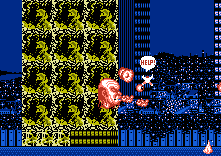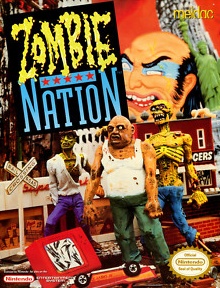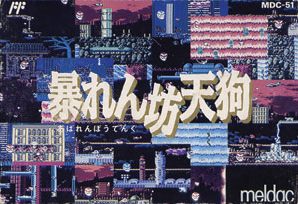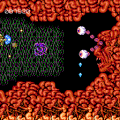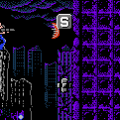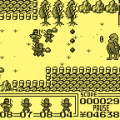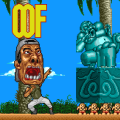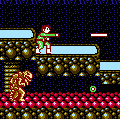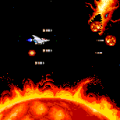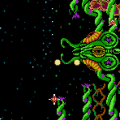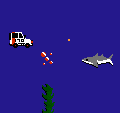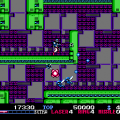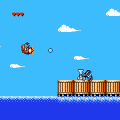What happens when a giant orange disembodied samurai head tears up the United States of America in a quest to retrieve his magical sword from an ominous alien force which has mentally enslaved the nation’s citizens? The actual result would probably be terribly gruesome and apocalyptic, but in the context of one of the strangest games to ever illuminate (or blight) the Nintendo Entertainment System, what we have is a product that is as awesomely horribly as it is horribly awesome. Zombie Nation (no relation to the techno artist famous for the classic rave hit “Kernkraft 400”) is the product of obscure developer KAZe and equally obscure publisher Meldac. This team was headed by Norio Nakagata, who worked on several Namco arcade games, including Genpei Tōma Den and Berabōman and later worked on the two Super Pinball titles for the Super Nintendo/Famicom, as well as Saturn pinball titles Last Gladiators and Necronomicon. Zombie Nation has nothing to do with pinball; it is one of many sidescrolling shoot-em-ups on the NES, a genre best known for featuring small airfighters flying through the clouds or space as opposed to giant samurai heads that barf explosive goo and fire out their eyeballs.
Zombie Nation is a truly ridiculous game, as evidenced by its story. Oh, and its protagonist, setting, bosses, and even its music to a degree. But let’s start with the story. In the near-future of 1999 (at least the near-future of when the game was released), a meteor plops down into the wastelands of Nevada. No one thinks anything of it until the meteor’s inhabitant reveals itself as Darc Seed (sic), a vile alien who shoots out magnetic rays and hypnotizes everyone in America. He even rips off Ghostbusters II and controls the Statue of Liberty, and his zombie slaves bring to him many deadly weapons. Amidst America’s many weapons, which can be assumed to include tanks, jets, and battle cruisers, the Japanese sword Shura is somehow the most powerful weapon ever. The fact that a Japanese sword was found in America notwithstanding (it was probably in a museum), Shura once belonged to the “great head of the samurai” (modeled after Tadataka Ohkubo Namakubi), who exists today as a great floating undead samurai head. Aye, Namakubi is an ACTUAL head, not the “head” of something as in the leadership sense. (“Kubi” technically means “neck” in Japanese, but it the connection of beheading someone as well. Hence, the head.) Angered at Darc Seed’s unjust possession of his weapon, Namakubi flies out of some creepy shack and intends to save America from Darc Seed’s zombification plague, dealing with soldiers armed with guns, tanks, helicopters, and other machines for which you would not expect zombies to be qualified pilots. Incidentally, the title screen actually reads “Samurai Zombie Nation”, with the kanji for “samurai” in the background, but this is not reflected on the packaging or anywhere else as the official title.
Long story short: Samurai in USA. Don’t question it, it is what it is. Zombie Nation is a rather short, only offering four levels, but each one is fairly lengthy at about five to seven minutes each. At least you get to select which level you want to start on for a bit of replay value, as well as choose between Easy and Hard difficulties. Each level has a reasonably distinct appearance accurate to its appropriate geographical location you see on the starting map. For example, the first level on America’s east coast is a big cityscape full of skyscrapers, and you are most definitely in New York City for this level, a fact that becomes apparent at the end boss.
Namakubi himself controls rather dubiously, tending to float for a split second more in the direction you fly after releasing the control pad. He turns somewhat sluggishly and has a bit of overall inertia to his movement, which can make it tricky to avoid enemy fire until you get used to his odd handling. On top of that, he is a rather large target that will likely be hit by several bullets at once. Thankfully, Namakubi can actually take a good deal of punishment before giving up as opposed to most shmup fighters that blow up if so much as a low-power laser grazes their wings. Namakubi’s life is represented by eight creepily-animated heads munching air at the bottom of the screen; taking enough damage causes one of the heads to turn into a skull, and if all eight become skulls, Nammy falls to the bottom of the screen shouting a Kanji meaning “regret” and your game is over. Some attacks do more damage than others, with the worst possible danger often coming in the form of vertical lasers that intermittently flare straight up. Grazing these hazards instantly drops your life down to one point, causing an obnoxious two-note danger siren to muffle the stage’s music until you inevitably die. If you manage to stay alive long enough after taking damage, you will regain approximately a head of health for every 10,000 points you net from enemy and property demolition. You only have a limited number of five continues at the game’s start, though scoring enough points nets you extra tries.
Our “heroic” samurai head does not care about amassing billions in high property damage in his quest to “save” America. Namakubi simultaneously attacks by firing out infinitely re-spawning eyeballs and hocking up oddly-shaped clumps of explosive matter from his mouth. His attacks are fairly slow, but you can fire faster and more projectiles simultaneously by collecting humans. Aye, destroying the terrain causes non-hypnotized humans to fly through the air and shout “HELP,” and if you pick them up before they splat onto the ground, you are one point closer to reaching level 2 of Namakubi’s power. The power gauge is represented by a track-and-field runner dashing towards the power-up marker. Collect four humans to reach level 2 to increase both the power and the frequency of your disgusting projectiles, and collect four more to boost it up to the maximum level 3. Collecting four more after that will highlight a star and allow you to use a screen-clearing bomb that, while useful, does not often destroy enemies that take multiple hits.
Naturally, your power drops to level 1 if you have to continue, making the game somewhat harder if you have to revive. However, the challenge comes more from Namakubi’s great big unwieldy head than the surprisingly high amount of bullets you will have to avoid. The difficulty feels more artificial than authentic, as you can fly around somewhat lazily, take a substantial amount of punishment and still having about three heads of life remaining. While you become quite powerful at level three, your arsenal is regardless rather limited and the gimmick of blasting out eyeballs gets old fairly quick. Though the stages drag out and may become a tad boring despite the massive amount of property damage you can wreak, the bosses are entertaining, challenging, and just plain weird. True to the intro storyline, the first stage boss is indeed the Statue of Liberty, having been corrupted by Darc Seed’s magnetic mind control as indicated by her crown having been transformed into a pile of Medusa-esque snakes. She spits out a myriad of bubbles and attempts to toast you with her now-real torch which can easily burn off all of your lifebar.
The second level takes place on the arid wilderness of the west coast, where you storm a military base on rocky terrain (Area 51, perchance?) and roll down a cliffside full of white water rapids. The latter stage is particularly frustrating due to fast-falling rocks that are very difficult to dodge along with strong raft-riding zombies and large snakes that scale up and down the waters. It concludes with one of the strangest bosses in sidescrolling shooter history: A muscular old bearded man in a speedo who bounces around the screen tossing axes. This boss is apparently an older rendition of American folk hero Paul Bunyan, although Japan took quite a few liberties in his portrayal here. Despite this, he is probably the hardest boss in the game due to his unpredictable movements and the ability to kill you instantly if you touch either him (eww) or his axes.
The following two levels are technically less interesting than the previous two, though there remains some strangeness strewn about. Level 3 is actually rather standard for shoot-em-up fare, featuring the exterior and interior of a toxic factory placed in Texas with a mechanical feel, complete with life-draining smokestacks and invincible air mines. This level has the most “conventional” boss, albeit a neat one which takes a page from R-Type‘s infamous warship fight. You take on a giant train full of turrets and lasers which you have to survive as you fly towards the train’s vulnerable core. The fourth level only has one part to it but is suitably chaotic, taking place in a spooky lava cave hidden in America’s northern Midwest region. Lots of bats, slime ghosts, and lava monsters attempt to take you down as the burning ooze lies below many stalactites. It is difficult to properly describe the boss here, but do your best to envision four shark-like mouths floating around the screen, spitting bullets and leaving trails of minuscule yet dangerous orbs, attempting to restrict your movement as they try to bite you directly which often results in an instant death.
If you manage to beat all four stages before all of your continues expire, you will travel above Earth’s atmosphere to be granted an audience with Darc Seed himself, who turns out to be a large green stereotypical humanoid alien in a horizontal resting position, presumably sleeping on some invisible space bed. He does not move and can be shredded very quickly if you are at maximum power, making this final battle somewhat anticlimactic. However, the blue orbs floating around him CAN kill you almost instantly, so if you are still not used to Namakubi’s off-kilter controls at this point, you should hope to have a few spare continues. Victory over the vile alien cuts to the most awesomely patriotic ending since Sylvester Stallone‘s hammy POW speech at the end of Rambo: First Blood Part II. A group of military jets fly over the White House as the good ol’ Stars and Stripes rises up above the White House. Three “CONGRATULATIONS!!!” scroll across the screen in large red text, and various images of the American countryside interspersed with close-ups of the flag and the unfitting Meldac logo before cutting to the credits. Consider yourself a hero!
Aesthetically, the game is kind of a mixed bag, especially so as a title in the twilight years of the NES. In graphical terms, Namakubi himself is somewhat oddly animated, the fire effect that appears when you destroy scenery looks weird contrasted against the rest of the terrain, most enemy sprites are rather uninteresting and static, and a bunch of sprite flickering occurs when there are more characters on-screen than the engine can handle. On the other hand, all of the bosses look impressive and many of the backgrounds look decent, particularly the first half of stage 2 which features gloomy clouds that fire lightning which can sap your life in no time flat. The music is actually quite interesting and eclectic, and it is arguably the best part of the whole package. The standout tracks are for the second half of stage 1, a surprisingly serene night time flight time ditty, and the stage 4 music, a blazing and frantic track which characterizes the spirit of the lava cave quite well. The award for most bizarre track has to be for stage three’s latter half, which starts out sounding like a threatening horror tune before making a schizophrenic change into an unbelievably peppy dance number. While the music is often cool, the aforementioned danger tune for when you are about to die unfortunately overrides the BGM.
This overall inconsistent quality could be excused if Zombie Nation was the greatest shoot-em-up since Gradius II (speaking of Gradius II, the classic UUDDLRLRBA Start Konami code actually works here to instantly restore your lifebar once per continue), but it is not all that impressive as a basic game. The loose controls, the lack of weapon variety, and the short amount of stages make this pretty humdrum from a purely mechanical standpoint. On the other hand, it may be at least worth a play due to its bizarre premise, good music, and the somewhat sloppy design that drops this game square in the “kusoge” realm. This is not a good game, but it is a game that allows you to settle the jingoistic issue of whether or not a floating samurai head could beat the Statue of Liberty in an eyeball-to-torch fight. So it has that going for it.
The whole concept of Namakubi is, somewhat ironically, the most significant difference from the game’s original Japanese version. The large floating orange samurai head was originally a large floating red mask resembling the face of a tengu, a Japanese folklore demon often depicted as having a long nose. The change is somewhat understandable, as tengu are deeply rooted in Japanese mythology of which most Americans are likely not aware while samurai were popularized by various media in America via classic jidaigeki films. The original game was titled “Abarenbou Tengu” the word “Abarenbou” itself translating into “hooligan.” The game’s tagline was “Excitengu”. Aside from having different animations from Namakubi, the tengu plays mostly the same, except that you have to manually mash the fire button if you are at the lowest power level. Furthermore, the Statue of Liberty is red, but does not have the snake hair of her blue American counterpart. Everything else is more or less the same in terms of both lameness and weirdness. Abarenbou Tengu was almost as obscure in Japan as Zombie Nation was in America, but it was notable enough to be featured in season 9 of the awesome classic video gaming show Game Center CX, now known to America thanks to the DS parody title Retro Game Challenge and Kotaku’s English translation, Retro Game Master.
Links:
Abarenbou Tengu A walkthrough of the Japanese game.
Screenshot Comparisons
